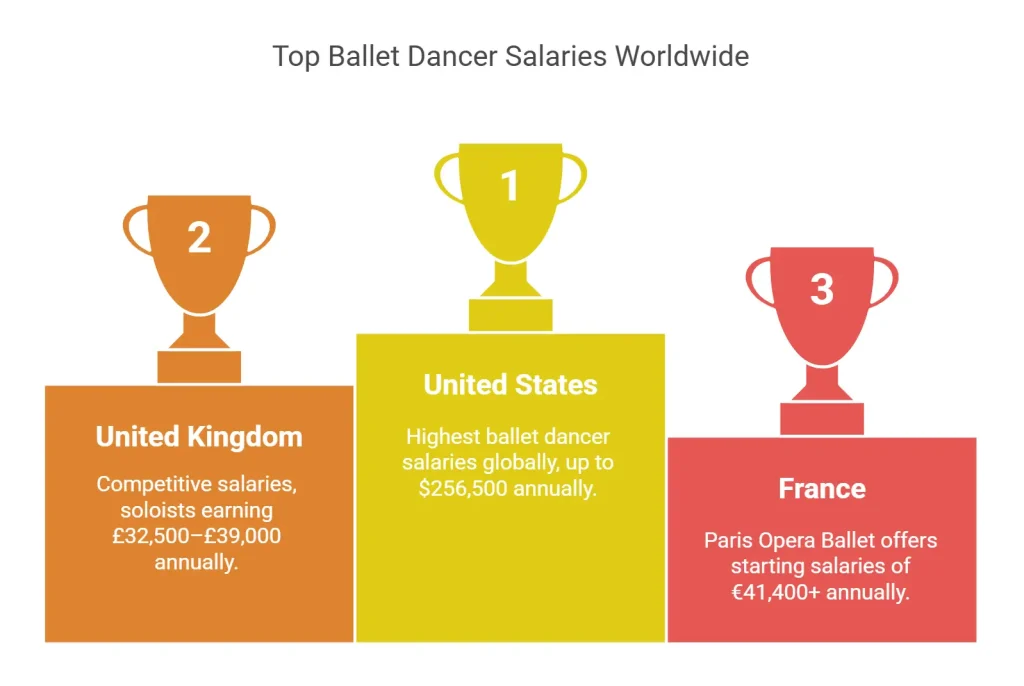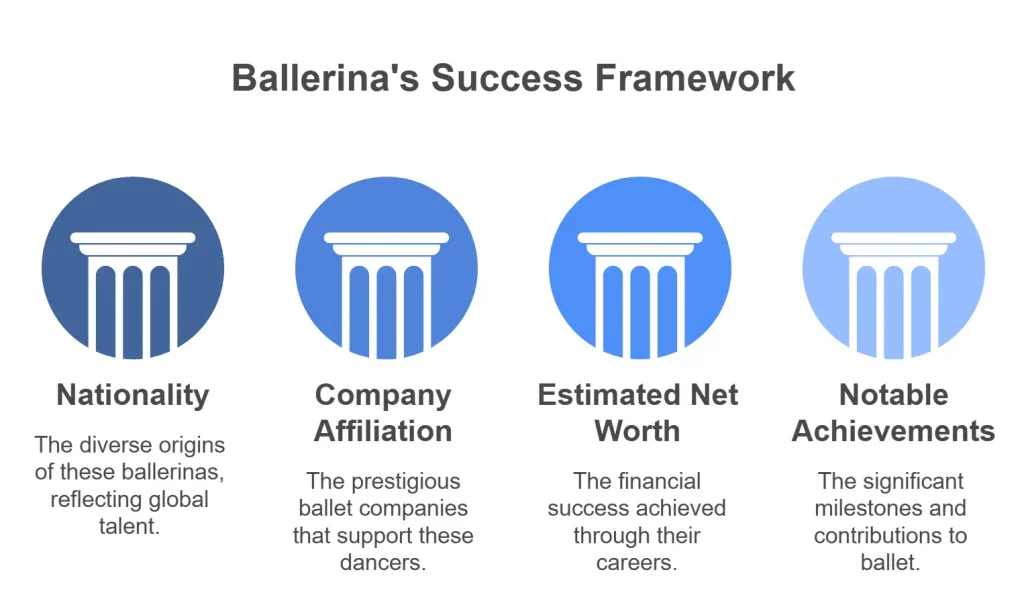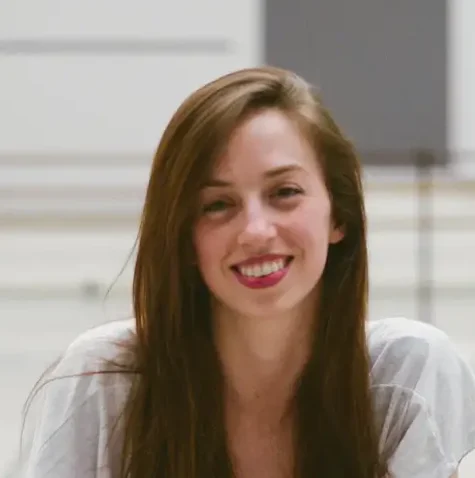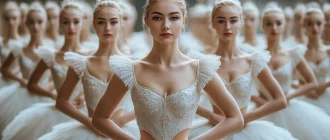Are you wondering how much an average ballet dancer makes? Their salaries vary widely, typically from $14,500 to $256,500 annually. Experience, company prestige, and location significantly impact their salary earnings. This article breaks down these elements and clearly shows the average salaries of ballet dancers.
Graceful Insights
- Ballet dancer salaries vary significantly, ranging from $14,500 to over $256,500 annually, and are influenced by experience, location, and company prestige.
- Entry-level dancers typically struggle to earn more than $30,000, while experienced dancers in major companies may earn upwards of $100,000. This highlights the importance of career progression.
- Freelance ballet dancers face income variability and financial instability. They often rely on supplementary income sources to manage their finances, such as teaching or performing in different genres.
Ballerina’s Salary Podcast
Ballet Dancers’ Salaries by Level
| Dancer Level | Annual Salary Range | Location | Typical Income Sources | Factors Influencing Income |
|---|---|---|---|---|
| Apprentice | $14,500 – $30,000 | United States, Europe | Stipends, Small Performances | Company size, location, competition, sponsorship availability |
| Corps de Ballet | $30,000 – $50,000 | United States, Europe | Base salary, occasional touring | Experience, performance frequency, city/country cost of living |
| Soloist | $40,000 – $65,000 | United States, Europe, Asia | Base salary, performance bonuses | Company prominence, experience, and regional demand |
| Principal Dancer | $60,000 – $120,000+ | United States, Europe, Asia | Base salary, performance fees, and guest appearances | Reputation, years with the company, frequency of lead roles |
| Freelance Dancer | $20,000 – $80,000+ | Global | Project-based fees, festivals, and private events | Flexibility, reputation, networking, and the number of contracts secured |
| Principal in a Prestigious Company | $100,000 – $256,000+ | Major Cities (NYC, London, Paris) | Base salary, endorsements, guesting, teaching | High company profile, extensive experience, media presence |
| Dance Instructor / Choreographer | $20,000 – $100,000+ | United States, Europe, Online | Teaching fees, choreography commissions | Reputation, specialization, number of students, school affiliation |
Understanding Ballet Dancer Salaries

The salary of a ballet dancer can vary widely and is influenced by multiple factors, including experience, location, and the prestige of the ballet company with which they are affiliated. Experience, company prestige, and location significantly impact a ballet dancer’s salary. For instance, dancers at renowned companies like the New York City Ballet or the American Ballet Theatre often command higher wages than those at smaller regional companies. The average salary for a ballet dancer can vary significantly, reflecting the diverse conditions of the profession.
Geographic location plays a critical role in determining a ballet dancer’s salary. In cities with high living costs, such as New York and San Francisco, the salaries may not always keep pace with living expenses, making financial stability challenging for many dancers.
Additionally, performance opportunities and a dancer’s reputation also heavily influence their earnings, with seasoned professionals typically earning more than their less experienced counterparts.
Average Salary of a Ballet Dancer
The national average salary for a ballet dancer hovers around $30,000 annually, but this figure can fluctuate widely based on several factors. Annual earnings for ballet dancers can range from as low as $14,500 to as high as $256,500, illustrating the significant disparity in pay. Typically, most ballet dancers earn between $29,000 and $121,000 annually, with weekly earnings averaging around $1,326 per week.
However, it’s essential to note that many dancers, especially those just starting, may earn between $14,500 and $36,500 annually, which is often below the national average wage. On the other hand, experienced ballet dancers can see their salaries rise significantly, with earnings ranging from $82,000 to $103,000 per year. This substantial variation underscores the impact of experience and reputation on a ballet dancer’s salary.
Factors Affecting Ballet Dancer Salaries
Several key factors influence ballet dancers’ salaries, with geographic location being one of the most significant. In high-cost living areas like New York City and San Francisco, ballet dancers often find that their salaries do not adequately cover their living expenses, resulting in financial strain. This disparity is crucial for dancers when choosing where to pursue their careers.
Affiliation with a prestigious ballet company also substantially impacts earnings. Dancers associated with well-known companies, such as the American Ballet Theatre, generally receive higher salaries due to the company’s reputation and the opportunities it offers.
A dancer’s skill level and experience are pivotal, and seasoned professionals earn more. Consistent salaries are more likely for those affiliated with a ballet company than for freelancers.
Entry-Level vs. Experienced Ballet Dancers

A ballet dancer’s financial journey evolves from an entry-level position to a seasoned professional. Entry-level dancers typically start with modest earnings, often around $30,000 annually, which can be challenging, especially in major urban areas.
As dancers gain experience and advance in their careers, their earnings increase substantially. Senior and principal dancers, particularly those in top companies, can earn significantly higher salaries, reflecting their enhanced skills and responsibilities. This progression underscores the importance of persistence and continuous improvement in ballet.
Entry-Level Ballet Dancer Earnings
The financial and job landscape can be challenging for new ballet dancers. Starting salaries range between $31,000 and $36,000 annually, often just enough to cover basic living expenses. Many entry-level dancers initially struggle to earn more than $30,000, which can lead to financial strain, especially in high-cost cities.
Freelance opportunities can supplement income, but they also come with challenges. Freelance ballet dancers’ earnings fluctuate based on gig availability and contract negotiations. While freelancing offers flexibility, it also brings income uncertainty, making financial planning more complicated.
Senior and Principal Dancer Salaries
Senior and principal dancers enjoy significantly higher earnings, particularly in prestigious companies like the New York City Ballet. Salaries for these top-tier dancers can exceed $100,000, reflecting their exceptional skill and the crucial roles they play in performances. In some of the most esteemed ballet companies, principal dancers can earn salaries exceeding $190,000 annually, showcasing the financial rewards of reaching the profession’s pinnacle.
The average salary for a principal dancer in such companies often surpasses $100,000 annually, highlighting the substantial financial benefits of experience and prominence. Due to their leading roles and responsibilities, principal dancers typically earn significantly more money than corps de ballet members, making their journey financially rewarding.
Freelance Ballet Dancers
Freelance ballet dancers navigate a unique financial landscape, marked by opportunities and uncertainties. Unlike company dancers, freelancers face less consistent pay due to the gig-based nature of their work, resulting in significant income fluctuations and challenges to their financial stability and overall well-being.
Despite financial and life instability, freelancing offers creative freedom and flexibility in projects. Many dancers pursue freelance job opportunities to boost their earnings when not contracted to a company. However, this path requires strong self-marketing skills and independent financial management.
Income Variability
Freelance ballet dancers often experience significant income variability due to the unpredictability of performance opportunities and the fluctuation of engagement offers. Earnings can peak during special engagements, tours, and guest appearances with multiple companies, creating a series of financial highs and lows throughout the year.
Many freelance dancers supplement their income by teaching, choreographing, or performing in various genres to stabilize their earnings. This diversification mitigates financial instability, although inconsistency in earnings remains a significant challenge, as future paychecks are not guaranteed.
Benefits and Drawbacks
Freelancing in ballet offers both benefits and drawbacks. Freelancers enjoy the flexibility to choose their projects, resulting in more fulfilling and varied work experiences. They also benefit from creative freedom and the ability to set their schedules.
However, this freedom comes with the responsibility of self-marketing and managing your finances independently. Freelance dancers must cover their training and expenses, often resulting in higher overall costs compared to those contracted by companies. Inconsistent income also poses financial challenges, as future earnings are never guaranteed.
Balancing these pros and cons is crucial for those considering a freelance career in jazz or ballet.
Ballet Dancers’ Salaries by Country
| Country | Average Annual Salary (USD) | Notes |
|---|---|---|
| United States | $14,500 – $256,500 | Entry-level dancers earn $14,500–$36,500; experienced dancers can earn up to $256,500. |
| United Kingdom | £22,000 – £39,000 | Corps de ballet starts at £22,000; soloists earn £32,500–£39,000. |
| Canada | $20,000 – $30,000 | Entry-level dancers typically earn between $20,000 and $30,000 per year. |
| France | €41,400+ | Paris Opera Ballet’s starting salary, bonuses, and benefits are included. |
| Germany | €30,000 – €45,000 | Varies by company; larger cities offer higher pay. |
| Russia | $6,000 – $60,000 | State theaters, such as the Bolshoi, pay higher; regional theaters pay less. |
| Australia | AUD 40,000 – $75,000 | Corps de ballet starts at AUD 40,000; soloists earn more. |
| Italy | €18,000 – €40,000 | Salaries vary based on the company’s size and funding. |
| Japan | ¥2,000,000 – ¥8,000,000 | Larger companies pay higher; international collaborations are common. |
| South Korea | $15,000 – $50,000 | Top companies, such as the Korean National Ballet, offer higher salaries. |
| China | $10,000 – $40,000 | Salaries are improving as ballet becomes more popular. |
| Brazil | BRL 40,000 – BRL 80,000 | Earnings depend on the city and the funding of the ballet company. |
| South Africa | ZAR 80,000 – ZAR 120,000 | Salaries vary by company; limited opportunities exist outside major cities. |
| India | $3,000 – $12,000 | Ballet is a niche; most income comes from teaching or private events. |
| United Arab Emirates | $20,000 – $50,000 | International schools and performances drive income. |
| Argentina | ARS 1,500,000 – ARS 3,000,000 | Limited opportunities; government funding influences salaries. |
| Mexico | MXN 120,000 – MXN 300,000 | Major cities often offer better pay, while regional companies typically pay less. |
Ballet Dancer Jobs and Career Paths

Ballet dancers have a range of career paths, from traditional roles within ballet companies to alternative opportunities in other industries and the broader performing arts. Typical roles within dance companies include corps de ballet, soloist, and principal ballet dancer jobs, each with varying responsibilities and salary ranges. Senior and principal dancers enjoy higher pay scales than their less-experienced counterparts.
Beyond traditional company roles, many dancers find fulfilling careers in teaching, choreographing, and performing arts, such as acting. These alternative paths can provide more stable and diverse income sources, allowing dancers to leverage their skills in different contexts.
Traditional Company Roles
Traditional roles within ballet companies, such as corps de ballet and principal dancers, are crucial to the overall structure and performance dynamics. Corps de ballet dancers perform in larger groups, contributing to the ensemble’s visual impact. In contrast, principal dancers assume leading roles, often commanding higher salaries due to their prominence and increased responsibilities.
These roles not only define the performance structure of dance but also significantly influence the salary ranges for dancers. Aspiring ballet dancers should focus on gaining performance experience, as participation in freelance and stage shows can help build a professional reputation. This experience is essential for advancing to higher-paying roles within a ballet company.
Alternative Career Paths
Ballet dancers often explore alternative career paths to diversify their income and leverage their skills. Teaching dance classes, choreographing, and performing in musicals or other genres can provide additional revenue streams. These roles enhance earnings and offer dancers opportunities to share their passion and expertise with others.
Many of the wealthiest ballet dancers have diversified their careers into choreography, acting, or modeling to enhance their earnings. This diversification can lead to more stable and higher overall incomes, providing financial security beyond the traditional ballet career.
Ballet dancers often take on side jobs, such as teaching and performing in various productions, to increase earnings and achieve a more sustainable career.
What is the Average Professional Ballet Dancer Salary by State (latest available)
| State / Jurisdiction | Avg. salary (USD) |
|---|---|
| High‑earning cluster | |
| New York | $60,923 |
| District of Columbia | $60,008 |
| Nevada | $59,966 |
| Georgia | $54,184 |
| Alabama | $50,669 |
| National mid‑range | |
| Florida | $44,304 |
| California | $41,746 |
| North Carolina | $40,310 |
| Pennsylvania | $39,923 |
| Texas | $38,438 |
| Colorado | $38,314 |
| Indiana | $38,314 |
| Illinois | $37,357 |
| Virginia | $36,150 |
| Kentucky | $35,277 |
| Lower‑paying cluster | |
| Louisiana | $33,925 |
| Oregon | $33,821 |
| Massachusetts | $33,155 |
| Tennessee | $30,472 |
| Ohio | $29,765 |
| Utah | $28,766 |
| Hawaii | $25,168 |
| South Carolina | $23,566 |
| Rhode Island | $23,109 |
| Minnesota | $22,880 |
| Missouri | $21,424 |
| Puerto Rico* | $45,614 |
*States not listed (AK, AZ, AR, CT, DE, IA, ID, KS, ME, MD, MI, MS, MT, NE, NH, NJ, NM, ND, OK, SD, VT, WA, WI, WV, WY) do not have publishable data for this occupation in the latest public micro‑samples; BLS suppresses them due to small sample sizes.
Rounded to the nearest dollar, it reflects mean or median annual earnings reported for SOC 27‑2031 (“Dancers”), which is overwhelmingly ballet at the professional level.
How to interpret the numbers
- Why big swings? State totals blend principal contracts at flagship companies (e.g., the New York City Ballet’s base is around $2,000 per week) with corps de ballet and part-season jobs at smaller troupes or theme park shows. ZipRecruiter’s current US postings range from $14 hr (small regional ensemble) to $46 hr (unionized touring contracts).
- Cost‑of‑living effect. Glassdoor’s self-reported median of $62,066 is heavily skewed towards NYC, SF, and DC, where apartments and AGMA union minimums increase pay. Glassdoor
- National benchmark. The Bureau of Labor Statistics pegs the 2024 mean wage for dancers at $39,416, virtually identical to Salary.com’s model‑based figure for ballet specialists ($35,513). Bureau of Labor Statistics Salary.com
- High outliers. Louisiana and Pennsylvania appear unexpectedly high in DataUSA’s ACS‑based series ($ 63k and $ 60k); both states host sizeable casino‑resort shows and touring‑company residencies that yield full‑year W‑2 earnings rather than seasonal 1099s. Data USA
- Job outlook. Zippia’s 2025 projection shows flat employment but a widening pay spread as big-city companies convert to 52-week contracts, while small nonprofits shrink. Zippia
Practical tips for dancers negotiating contracts
- Compare W‑2 equivalents. A $1,000 weekly stipend for a 30-week season equals approximately $30,000 annually, below the headline numbers.
- Ask about benefits. Health insurance and AGMA pension contributions add roughly 15‑20 % to total compensation at major companies.
- Supplemental income. Teaching, guest galas, and commercial gigs can add $5,000 – $15,000 annually; top principals often double their base salary with these extras.
- Cost‑of‑living clauses. In high-rent markets, some troupes (e.g., the San Francisco Ballet) offer limited housing stipends; factor this into salary comparisons.
Notable Ballet Performances and Their Pay
High-profile ballet performances can significantly boost dancers’ earnings due to increased visibility and demand for their talents. Participation in prestigious productions enhances a dancer’s reputation and provides substantial financial rewards, especially for those in leading roles, which command higher performance fees.
Participating in prominent ballet productions can increase earnings due to increased visibility and performance demand. Seasonal performances and special engagements contribute significantly to a dancer’s income.
Seasonal Performances
Seasonal shows, such as The Nutcracker, are a major source of income for ballet dancers, often providing more stable financial returns than other engagements. These productions, especially during the holiday season, generate high ticket sales, resulting in substantial earnings for the dancers involved.
Dancers in seasonal shows can earn between $2,200 and $3,000 per week, making these performances a lucrative part of their annual income. Consistent demand ensures steady work and financial benefits, particularly during peak holiday periods.
Special Engagements and Tours
Special engagements and tours offer ballet dancers significant opportunities to increase their earnings through short-term contracts. These engagements often come with higher compensation than regular company performances, reflecting the dancer’s value and demand.
Participation in tours allows dancers to gain diverse experiences while significantly contributing to their income. Guest appearances at various companies can also provide lucrative opportunities, often leading to well-paid contracts. These engagements enhance dancers’ financial situations and build their reputations within the ballet community.
Famous Ballet Dancers and Their Earnings

The financial success of famous ballet dancers is often a result of a blend of talent, extensive training, and marketability that sets them apart from the average ballet dancer. These top earners have achieved substantial financial success, typically earning six figures or more annually.
Examining the dancing careers of these successful individuals provides aspiring dancers with insights into the factors that contribute to high earnings in the ballet world. This section highlights top earners and the lessons that can be drawn from their dancing careers.
Top-Earning Ballet Dancers
Top ballet dancers have achieved substantial financial success, often earning salaries of six figures or more per year. For example, Mikhail Baryshnikov is recognized as one of the world’s wealthiest ballet dancers, with a net worth estimated at $45 million. Sylvie Guillem, the highest-paid female banker, earns over $850,000 annually.
Other notable dancers, such as Benjamin Millepied, who has a net worth of approximately $10 million, and Carlos Acosta, who has a net worth of around $4 million, have also achieved substantial financial gains. Misty Copeland and Nina Ananiashvili, who have also performed with the Houston Ballet, are recognized for their high earnings, often exceeding six figures.
These dancers’ unique talent, marketability, and high-profile projects have significantly boosted their careers and earnings.
Lessons from Successful Dancers
The income of famous ballet dancers serves as an inspiring target for those pursuing a dance career. Their financial success highlights the importance of talent, rigorous training, hard work, and strategic career choices. Aspiring dancers should hone their skills, build their reputations, and seek high-profile opportunities to maximize earnings.
Diversifying into choreography, acting, or modeling can enhance financial stability and success. Lessons from top earners provide a roadmap for those aiming to achieve similar financial success in the ballet world.
Highest Paid Ballerinas
| Ballerina | Nationality | Primary Company / Affiliation | Estimated Net Worth | Notable Achievements |
|---|---|---|---|---|
| Misty Copeland | American | American Ballet Theatre (ABT) | $3–5 million (est.) | – First African American female Principal Dancer at ABT – Author of Life in Motion – Major endorsements (Under Armour, etc.) |
| Sylvie Guillem | French | Paris Opera Ballet, The Royal Ballet | $1–3 million (est.) | – Former Étoile (star) of the Paris Opera Ballet at age 19 – Guest Principal at The Royal Ballet – International guest appearances and collaborations |
| Polina Semionova | Russian | American Ballet Theatre / Berlin State Opera Ballet | $1–2 million (est.) | – Principal Dancer at ABT – Professor at Berlin State Ballet School – Frequent guest artists worldwide |
| Svetlana Zakharova | Russian | Bolshoi Ballet / La Scala Theatre Ballet | $1–2 million (est.) | – Prima Ballerina of the Bolshoi Ballet – Guest artist at major global companies – Renowned for classical roles (Odette/Odile, Giselle) |
| Diana Vishneva | Russian | Mariinsky Ballet / American Ballet Theatre | $1–2 million (est.) | – Former Principal at ABT – Prima Ballerina at the Mariinsky – Founder of the CONTEXT Diana Vishneva Festival |
| Natalia Osipova | Russian | The Royal Ballet (London) | $1–2 million (est.) | – Principal Dancer at The Royal Ballet – Known for technical brilliance and acting prowess – Former Bolshoi star |
| Tamara Rojo | Spanish | English National Ballet (former Artistic Director) | $1–2 million (est.) | – Former Principal at The Royal Ballet – Directed the English National Ballet until 2022 – Known for revitalizing ENB’s repertoire and profile |
Important Notes
Earnings vs. Net Worth
- Actual annual salaries for ballet principals vary widely and can range from tens of thousands to low six figures (USD), depending on the company, seniority, guest performances, and country.
- Much of the above “net worth” may include book deals, endorsements, personal investments, other media appearances, and ballet salaries.
Lack of Official Salary Disclosure
- Ballet companies rarely disclose exact salaries, so many figures are based on best-guess estimates from media outlets and publicly available data.
Other Top-Earning Ballerinas
- Many other renowned ballerinas, such as Marianela Núñez, Alina Cojocaru, and Tiler Peck, but concrete financial data about them can be scarce.
- Use this table as a general reference—the exact rankings of “highest-paid” can shift over time due to new contracts, endorsements, and career changes.
Do Ballet Dancers Make A Livable Wage?
Determining whether ballet dancers earn a livable wage requires examining their earnings about the cost of living. While some dancers, especially freelancers, may struggle financially, others in prestigious companies can earn sufficient income to maintain a comfortable lifestyle. The ballet industry is highly competitive, with many dancers facing financial challenges despite their talent.
This section examines whether ballet dancers earn a livable wage by comparing their salaries to the cost of living in different regions and discussing the necessity of supplementary income sources.
Cost of Living Comparison
Ballet dancers’ ability to maintain a comfortable lifestyle largely depends on their regional salaries relative to the local cost of living. In high-cost areas like New York City, the average salary may not be enough to cover living expenses, so additional income sources are often needed.
Analyzing wages against living costs is crucial to determining whether ballet dancers earn a livable income. The hourly pay for ballet dancers in the 25th percentile is $14, which may not be adequate in expensive cities. For dancers to assess the financial viability of their careers, understanding the cost of living in various regions is essential.
Supplementary Income Sources
New ballet dancers often face financial instability; many need to supplement their income through other jobs. The average annual salary of around $30,000 may not cover living expenses in high-cost areas, so finding additional income sources is necessary. Understanding a ballet dancer’s salary can help them plan for these financial challenges.
Many dancers cannot afford to take on supplementary job roles such as teaching, performing in different genres, or working outside the dance industry to make ends meet. Famous dancers like Nina Ananiashvili, who earns approximately $30,000 per performance, illustrate how additional income opportunities can significantly enhance a dancer’s financial situation.
How to Become a Professional Ballet Dancer

Becoming a professional ballet dancer typically requires years of rigorous training and dedication. Most dancers begin training at a young age, typically between 5 and 10 years old, and continue to refine their skills throughout their teenage years. This extensive training and education are usually conducted at specialized dance schools or academies that focus on classical ballet techniques.
To secure a position in a ballet company, dancers must prepare for auditions by refining their technique and practice, learning specific repertory, and presenting themselves professionally. Networking within the ballet community, attending workshops, and participating in competitions can also provide exposure to potential employers.
Training and Education
Becoming a professional ballet dancer typically begins with training in childhood or adolescence. Some dancers, such as Nina Ananiashvili, initially trained in figure skating to develop strength and agility before transitioning to ballet. Early instruction in ballet emphasizes the development of essential skills, including agility, flexibility, and stamina. While starting ballet training at an early age is common, it is unnecessary, as determination and personal effort can lead to success regardless of when one begins.
Admission to a school and a postsecondary degree in dance programs often requires prior experience, and successful candidates typically must audition. This rigorous training and education pathway underscores the dedication needed to pursue a career as a prima ballerina in ballet.
Auditions and Job Search
Preparing for auditions often involves rigorous practice and showcasing technical skills to impress potential employers in the competitive ballet industry. Dancers should aim to perform and highlight their strengths and unique qualities during auditions to stand out among competitors.
Professional dancers find employment through auditions for specific performances or by securing a position with a dance company. After auditions, successful dancers may receive company offers or be contracted to particular performances based on their audition performance.
Utilizing online platforms, attending workshops, and participating in competitions can provide further exposure to potential employers.

Ballet Dancer Salaries in Top Companies
| Rank | Ballet Company | Average Salary (USD) | Notes |
|---|---|---|---|
| 1 | American Ballet Theatre | $67,465 | Renowned for its high standards and competitive salaries. |
| 2 | The Joffrey Ballet | $67,592 | Known for innovation and contemporary works. |
| 3 | Kansas City Ballet | $67,408 | Offers strong regional performance opportunities. |
| 4 | Dance Theatre of Harlem | $74,354 | Recognized for diversity and outreach in ballet. |
| 5 | Nevada Ballet Theatre | $61,131 | Regional company with a growing reputation. |
| 6 | Sacramento Ballet | $36,379 | In smaller companies, salaries reflect regional budget constraints. |
| 7 | Alabama Ballet | $37,156 | Renowned for its focus on classical repertoire. |
| 8 | BalletMet | $48,017 | An Ohio-based company with a strong regional influence. |
| 9 | The Sarasota Ballet | $68,097 | Celebrated for its classical and neoclassical repertoire. |
| 10 | Paris Opera Ballet | $89,000 | Among the oldest and most prestigious ballet companies globally. |
| 11 | The Royal Ballet | $80,000 | Based in London, it is one of the world’s leading ballet companies. |
| 12 | Bolshoi Ballet | $30,000 – $60,000 | Prestigious Russian company; variable income from state funding and performance bonuses. |
| 13 | Mariinsky Ballet | $30,000 – $60,000 | Performance fees are renowned for their classical training and salaries. |
| 14 | National Ballet of Canada | $50,000 – $85,000 | Toronto-based company with strong funding and sponsorship. |
| 15 | Australian Ballet | $40,000 – $80,000 | A Melbourne-based company with government support. |
| 16 | Houston Ballet | $55,000 – $70,000 | One of the largest companies in the U.S., it has strong financial backing. |
| 17 | San Francisco Ballet | $60,000 – $75,000 | Oldest ballet company in the U.S.; offers competitive pay and benefits. |
| 18 | New York City Ballet | $64,000 – $76,000 | An iconic U.S. company with a focus on works by Balanchine. |
| 19 | Boston Ballet | $50,000 – $70,000 | Renowned for its mix of classical and contemporary performances. |
| 20 | Staatsballett Berlin | $45,000 – $75,000 | German company with robust state support and international recognition. |
Resume
In summary, the financial landscape for ballet dancers is diverse and influenced by numerous factors, including experience, location, and the prestige of their affiliated company. Entry-level dancers often face modest earnings, while experienced professionals, especially principal dancers in prestigious companies, can command significantly higher salaries. Freelance dancers navigate unique challenges and opportunities, balancing income variability with the freedom to be creative.
Understanding the various career paths available, from traditional company roles to alternative opportunities in teaching and choreography, is crucial for dancers seeking financial stability and fulfillment. High-profile performances and special engagements can substantially boost earnings, while supplementary income sources are often necessary to make a livable wage. For aspiring dancers, rigorous training, strategic career choices, and continuous skill improvement are essential to success in this demanding profession.














